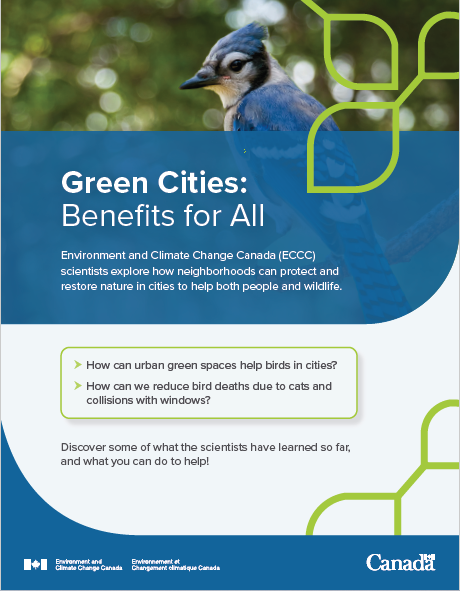Bird safety in urban spaces
Green cities: benefits for all
Our scientists explore how neighborhoods can protect and restore nature in cities to help both people and wildlife:
- how can urban green spaces help birds live in cities?
- how can we reduce bird deaths due to cats and collisions with windows?
Discover some of what the scientists have learned so far, and what you can do to help!
Urban rest stops and more!
Why do we find so many birds in cities?
- many Canadian cities are along migratory routes
- birds that migrate at night can be attracted to cities by the bright lights
Along with our partners at McGill University, we are uncovering how important high quality urban greenspaces are for migratory birds that stopover in cities.
What kind of habitat do birds use while in cities during their migratory journeys? Scientists found that some birds spend 4x more time in shrubby forest edges than in open forests or fields.
Birds nesting in the boreal forest, such as Tennessee Warblers and Swainson’s Thrushes, spend up to 1.5 months in Montreal greenspaces before heading south in the fall. During that time, they need safe places to regrow flight feathers to complete their migratory journeys!
Predators on the prowl!
Urban greenspaces provide food and shelter for migrating birds, but they can face many threats like predation by outdoor cats.
Along with the University of Guelph and our other partners, we are showing how communities can count outdoor cats, and understand how cat movements in cities may put birds at risk.
Most cats avoided parks and stayed close to buildings. This puts birds that visit backyard feeders at greater risk of predation. Others roam across areas as large as 38 hectares in Southwestern Ontario.
According to researchers’ estimates, did you know that there could be up to 48,000 cats roaming in Gatineau, Quebec?
Dangerous windows
Most fatal collisions occur in spring and fall when millions of birds are migrating through cities.
Single decals on windows don’t work! But we tested the effectiveness of closely spaced (less than 5 cm apart) markers on glass, and this reduced collisions by 95%!
Calls to action
There are many actions we can take to ensure safe passage for migratory birds:
- keep cats indoors, or with supervised outdoor access
- make windows safer – learn about bird collisions with glass windows to find out how
- work with neighborhoods to protect and restore nature in cities, including bushes for birds
- do some birdwatching and share your passion for birds
- share what you see on sites like eBird, the Global Bird Collision Mapper, and iNaturalist
